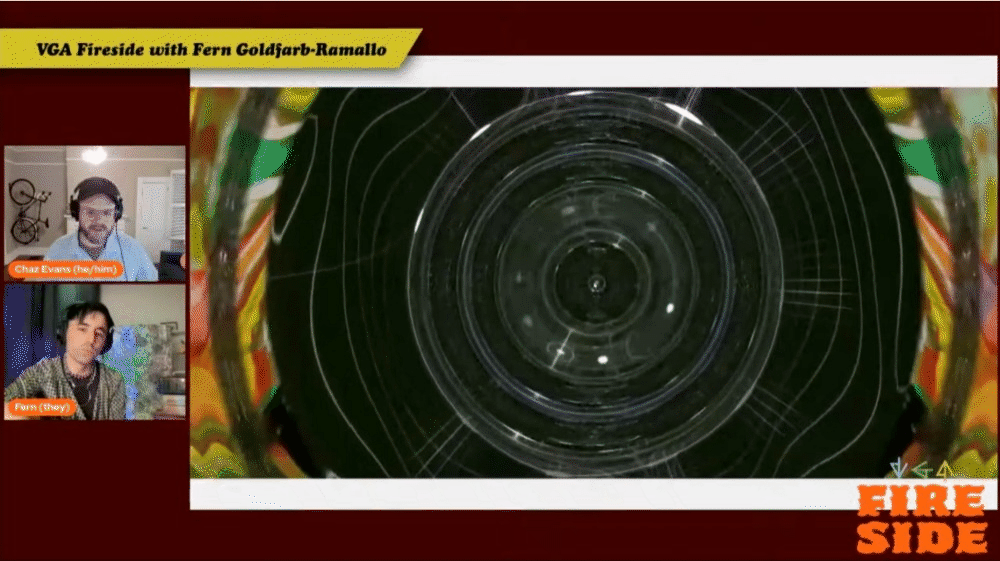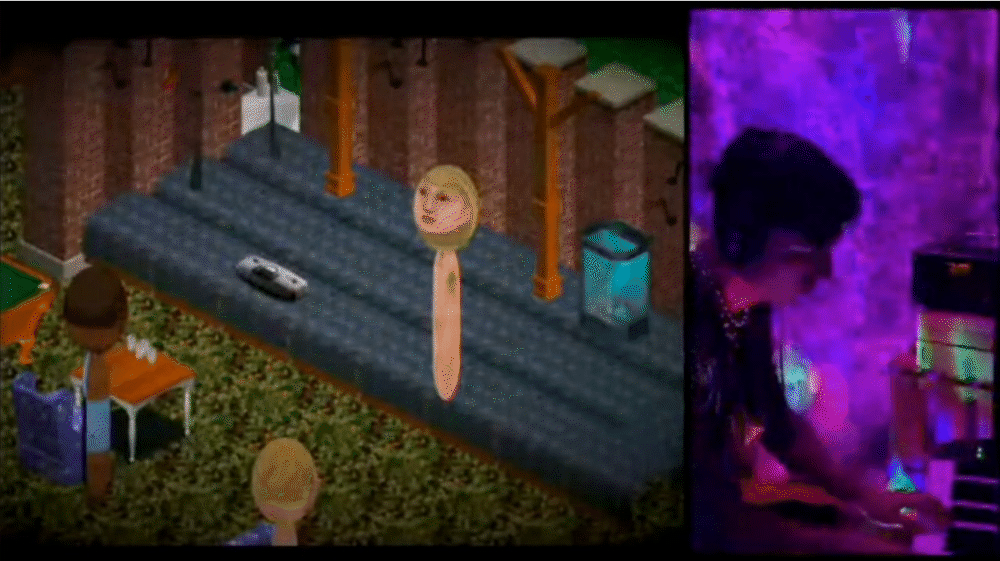VGA Fireside Ep. 13 feat. Fern Goldfarb-Ramallo: Interview Highlights
VGA Gallery had the honor of featuring Fern Goldfarb-Ramallo (@fernantastic) for our thirteenth episode of VGA FIRESIDE! Goldfarb-Ramallo is a creative coder, designer and visual artist based in Brooklyn and Berlin. They work across numerous platforms developing playful creative tools for digital artmaking. Their projects Panoramical and Raunchy Feast XXX were featured in past VGA Exhibitions The Ears Have Walls and Polymorphism, respectively.
Below are some of the highlights from Chaz Evans’ conversation with Fern, edited for clarity and brevity. The full interview can be found on VGA Gallery’s YouTube and Twitch channels, where you can see gameplay from their project Panoramical, as well as a live musical performance in conjunction with their other showcased work, The Sims: Rowdy Remixes.
On how they got started making video games
Fern Goldfarb-Ramallo: I always played games throughout my childhood, so it was a way of dealing with the world; they were made to not deal with the world. There were always computers around at home. Maybe even before they were a little more common, since both my parents worked with computers. They made accounting software. So there were definitely a lot of opportunities to check out games.
When I got into college, I never really thought about getting into making games. I studied visual design a little bit, like animation and art. But games came like much later in my early 20s, when I had the opportunity to work with a local games company and got a little bit of a window into what it actually takes to make a game. That was close to when the initial independent game scene was starting to happen.
I was hearing about and seeing a lot of new games coming out (this was around 2008) which were really piquing my interest in making games that were not just what you would see in the mainstream, but maybe a little more experimental. I learned the tools and started connecting with people that were also making games for living, which was kind of like, you know, wild, like back in the day. Years later, I'm still trying to make my own projects with wonderful people. That's how I got into it.
Chaz Evans: The community that you're interacting with are people you found online? Or in a particular city or institution?
FGR: A lot of it was online like in the age of like, maybe TIGSource, this forum for independent game game developers. Then I started going to conferences, like festivals, like IndieCade, GDC (Game Developers Conference)… all these events that were happening every year where people gather because they were interested in using video games as a medium for artistic creation, more than commercial games.
On the idea origin and preliminary process for Panoramical
FGR: So I had met what would become my collaborator, David Kanaga, at one of these festivals and what was happening often is that we would prototype or play around with some things. We were doing a lot of game jams at the time. This idea that we were all about was making very small experiments and seeing if something's there, or trying to make a small experience that you can shape and put out there, or show at one of these festivals that had a lot of opportunities to showcase work in front of a lot of people.
It was a very small community at the time and it was exciting for a newcomer to be able to have an audience for your work in front of you, excited to try different ideas. I also at the time I had a small community in Buenos Aires—a group of friends that were also making games. I had David and some people in this festival that I knew. There was certainly a feeling of a network of this creative energy happening in a space, to try new ideas and have them in front of people and seeing what happens.
And Panoramical came about from one of those moments where I was sitting with David after one of these big conferences. He had some MIDI controllers, those controllers that you can use to make music. I wasn't making any music at the time; I actually only started making music like last year. So this was all very unfamiliar to me, you know? This idea that you don't only have to make games for a games controller or a keyboard, you can use knobs and sliders and parts and keys.
Then we started playing with this idea of what if we use this device as a game controller rather than a regular game controller, and that's where we just play around with thing. I think we did a little thing where I put together some gameplay… I put in some shapes that grew and shrank based on the parts that you were changing. At the same time, he was sort of using the same device and controlling music parameters in a music software that he was very familiar with. So we ran both of the softwares together, getting input from the same controller, and basically had a new media art installation, like an interactive audio visual toy.
We kind of started to grow from there. There was a call for projects to show at IndieCade and we got this idea of like, Well, what if we work on this a little bit more and collaborate and show it around? And that's how it sort of came about.
On the experience of traveling around and exhibiting Panoramical
Panoramical at IndieCade. Image courtesy of Fern Goldfarb-Ramallo.
FGR: What we found as we were showing it to people was that, especially in environments that weren't quite always museums, like some festival out on the street, the audience wasn't necessarily versed with video games, but came to see it as an interesting exhibit. The way that a lot of people play it gave us a hint that we had something interesting going on with this kind of interaction.
We noticed that people that would have had a hard time grabbing a games controller and seeing it as a device that they might break, or that they might be confused by. But when you have a control that is unfamiliar, it makes you kind of like lean into it with a little more curiosity.
You have very clear moments, like this goes up, this goes down, this turns around. I think it puts people in a very playful sort of mindset. And I think what I tried to do from the design was to enable this sort of flow for the player, where you didn't need to wait to see a reaction from the game. As soon as you turn the knob up, you will see an immediate reaction in the game, both in the visuals and the sound. That made for a very tight experience. I noticed that people would really zone out to it.
Sometimes we will show it with either this controller and at some point, we built our own controller. Brendan Byrne, a friend from New York, made us this little box with a bunch of parts. And that made it so that you will see an even more unfamiliar sort of device, but that was very clearly built to be played with and fit more nicely in a gallery setting.
So we noticed a lot of different behaviors from people. From sharing the controller with a stranger, or people laying down on the floor, just observing the experience that someone was performing for them. And, you know, I saw little kids play it, and that was also really, really cool. It was very interesting to see how the control afforded a different kind of experience for people that really resonated.
On the inclusivity of alternative controllers
FGR: When you see a games controller, I think there's an element of shame and judgment that comes with approaching that device. A lot of people tell you, “I don't know how to play games. I might do something wrong, and I might be judged for it.” But if you're approaching an art installation with a custom control that looks like an alien device, you know, it's very clear that there's no wrong way to play it. It's there for you to play with.
On Fern’s growing relationship between creative coding and musicianship with The Sims: Rowdy Remixes
FGR: I think one thing that I can think about is at the time that I was making Panoramical, I definitely thought of myself, like tunnel vision, “Okay, I'm definitely gonna make games and use GameMaker and I don't anything else.” I think that held me back a little, and kept me from looking at other types of art creation, and a lot of other outputs for my creative energy. I thought of myself so much as an indie game developer that I would look at the music side of things as something that I left to David, or left for someone else to work on while I focused on game design. And I think it's very important as any sort of creator to always keep your tentacles on as many forms of expression as you can.
One lesson to take is, try to not dismiss other types of art that [could] have a lot to teach you as a creator. Just try and keep an open mind, engage with lots of different types of art, and also try and create lots of different types of art. I think that's the best way to bring all of these ideas back into games. Try and break off of this idea that you have to make this one type of game that has to go on Steam that has to say this, or that, or that you're not allowed to treat certain topics, certain subjects or certain matters that you care about. I think that’s important.
How do you situate your work in relation to the term “contemporary art”?
FGR: Escape.






